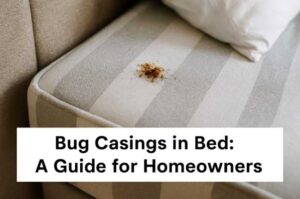You’ve just noticed itchy red marks on your arms after a night’s sleep. Or maybe you spotted tiny dark dots along your mattress seams. These are classic signs of bed bugs, one of the most frustrating and persistent pests’ homeowners can face. But where do bed bugs come from, and how can you keep them out of your home? If you’re searching for answers and reliable bed bug control in Ontario, you’re in the right place.
This blog will walk you through where bed bugs come from, how to spot them early, and the best ways to prevent and control infestations. Whether you’re a homeowner, renter, or business owner, these practical tips and expert insights will help you protect your space from bed bugs.
Where Do Bed Bugs Come From?
Bed bugs are sneaky travellers. They don’t fly, but they’re experts at hitchhiking. Most bed bug infestations start when these tiny pests hitch a ride into your home on luggage, clothing, or second-hand furniture. They can come from almost anywhere, hotels, public transportation, movie theatres, and even friends’ homes5.
Bed bugs are not a sign of poor housekeeping. Even the cleanest homes can get bed bugs. They’re attracted to warmth, carbon dioxide, and the presence of people, not dirt or clutter. However, clutter does give them more places to hide, making infestations harder to spot and treat.
How Do Bed Bugs Get Inside Your Home?
Here are the most common ways bed bugs enter your space:
- Travel: Bed bugs often hitch a ride in luggage, backpacks, or clothing after a stay in a hotel, motel, or even a friend’s home.
- Second-hand furniture: Used beds, couches, and other furniture can harbour bed bugs if not properly inspected.
- Visitors: Guests may unknowingly bring bed bugs into your home on their belongings.
- Shared spaces: Apartment buildings, dormitories, and multi-family homes can have bed bugs spread through walls, electrical outlets, or shared laundry rooms.
- Public places: Bed bugs can be picked up from buses, trains, movie theatres, and other public spaces.
How to Spot a Bed Bug Problem
Early detection is key to controlling bed bugs. Here are the most common signs:
- Bites: Small, itchy red bumps, often in a line or cluster on exposed skin.
- Blood stains: Tiny spots of blood on sheets or pillowcases from crushed bugs.
- Dark spots: Bed bug droppings look like small dark dots on mattresses, sheets, or furniture.
- Shed skins: As bed bugs grow, they leave behind pale, shell-like skins.
- Live bugs: Adult bed bugs are about the size of an apple seed, flat, and reddish-brown.
If you notice any of these signs, it’s time to take action.
Preventing Bed Bug Infestations
Prevention is always easier, and less stressful, than dealing with a full-blown infestation. Here are the best ways to keep bed bugs out of your home:
- Inspect second-hand items: Always check used furniture, mattresses, and clothing before bringing them inside.
- Be cautious when traveling: Inspect hotel rooms for signs of bed bugs. Keep luggage off the floor and away from beds. When you get home, wash and dry your clothes on high heat.
- Reduce clutter: Clutter gives bed bugs more places to hide. Keep your home tidy, especially in bedrooms and living areas.
- Seal cracks and crevices: Repair peeling wallpaper, tighten electrical faceplates, and seal gaps in walls, baseboards, and furniture.
- Use mattress and box spring encasements: Special covers can trap bed bugs already inside your mattress and prevent new ones from getting in.
- Vacuum regularly: Vacuum carpets, floors, and furniture frequently. Pay special attention to seams, folds, and cracks where bed bugs like to hide.
- Monitor for bed bugs: Use bed bug interceptors under bed and furniture legs to catch and monitor bed bugs before they reach you.
What to Do If You Find Bed Bugs
If you suspect you have bed bugs, don’t panic. Fast action can help prevent a small problem from becoming a big one. Here’s what to do:
- Confirm the infestation: Compare the bugs to photos online or consult a pest control professional to make sure you’re dealing with bed bugs.
- Don’t immediately use pesticides: Avoid over-the-counter sprays. Many bed bugs are resistant to common pesticides, and improper use can make the problem worse.
- Start with non-chemical methods:
- Wash and dry bedding, clothes, and curtains on the hottest settings.
- Vacuum thoroughly, then empty the vacuum outside in a sealed bag.
- Use steam cleaning on mattresses, furniture, and carpets.
- Freeze small items for at least four days at -19°C if possible.
- Use bed bug interceptors: Place these under bed and furniture legs to trap and monitor bed bugs.
- Seal infested items: Place items that can’t be washed or heated in sealed plastic bags or containers.
- Call a professional: Bed bug control is complex and often requires expert help. A pest control company like Wise Pest Solutions can inspect, treat, and monitor your home for bed bugs.
Integrated Pest Management (IPM) for Bed Bugs
Integrated Pest Management (IPM) is the most effective way to control bed bugs. IPM combines non-chemical and chemical methods to get rid of bed bugs with the least risk to your health and the environment.
Key components of IPM for bed bugs:
- Inspection: Thoroughly inspect your home to find all bed bug hiding spots.
- Non-chemical control: Use vacuuming, steam, heat, and encasements to reduce bed bug numbers.
- Chemical control: Use pesticides only as part of a comprehensive plan, and follow label directions carefully.
- Monitoring: Use interceptors and regular inspections to check for bed bugs after treatment.
- Prevention: Keep your home clutter-free, seal cracks, and use protective covers on mattresses and box springs.
Why Choose Wise Pest Solutions for Bed Bug Control?
At Wise Pest Solutions, we understand how stressful a bed bug infestation can be. Our team is trained to handle bed bug problems quickly, safely, and effectively. Here’s what you can expect when you choose us:
- Expert inspection: We’ll thoroughly check your home to find all bed bug hiding spots.
- Custom treatment plan: We’ll create a plan tailored to your situation, using the latest methods and products.
- Safe, eco-friendly treatments: We use proven, low-risk methods to protect your family and pets.
- Ongoing support: We offer follow-up visits and prevention advice to keep your home bed bug-free.
- Peace of mind: With Wise Pest Solutions, you can trust that your bed bug problem will be handled professionally and discreetly.
Tips for Different Home Types
Every home is different, and so are its bed bug risks. Here are some tailored tips for common home types in Ontario:
- Apartments and condos: Bed bugs can spread through shared walls. Report any signs to your landlord or property manager immediately. Work with your neighbours to prevent and control infestations.
- Houses: Inspect second-hand furniture and bedding before bringing it inside. Keep your home clean and clutter-free.
- Student housing: Bed bugs are common in dorms and shared housing. Be extra careful with shared laundry rooms and second-hand furniture.
- Vacation homes and rentals: Inspect the property for signs of bed bugs before unpacking. Wash all bedding and clothing after your stay.
Final Thoughts: Prevention and Control
Bed bugs are a challenge, but they’re not impossible to beat. By knowing where they come from and taking simple prevention steps, you can greatly reduce your risk of an infestation. If you do find bed bugs, don’t wait, start treatment right away and consider calling a professional pest control company like Wise Pest Solutions for expert help.
With the right knowledge and support, you can keep your home bed bug-free and enjoy peace of mind.
If you’re dealing with bed bugs or want to prevent an infestation, contact Wise Pest Solutions today. We’re your trusted partner for bed bug control in Ontario, because your home should be a safe, comfortable place for you and your family.










